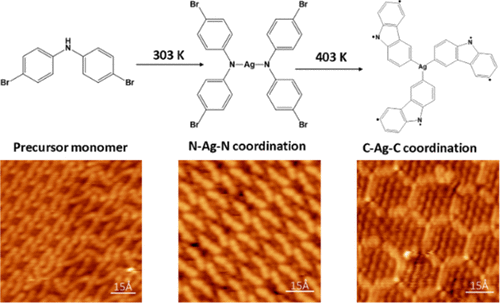当前位置:
X-MOL 学术
›
J. Phys. Chem. C
›
论文详情
Our official English website, www.x-mol.net, welcomes your feedback! (Note: you will need to create a separate account there.)
Stepwise Synthesis of N–Ag–N and C–Ag–C Organometallic Structures on a Ag(111) Surface
The Journal of Physical Chemistry C ( IF 3.3 ) Pub Date : 2020-07-03 , DOI: 10.1021/acs.jpcc.0c03745 Wenzhao Zhang 1 , Tao Wang 1 , Dong Han 1 , Jianming Huang 1 , Lin Feng 1 , Honghe Ding 1 , Jun Hu 1 , Zhiwen Zeng 1 , Qian Xu 1 , Junfa Zhu 1, 2
The Journal of Physical Chemistry C ( IF 3.3 ) Pub Date : 2020-07-03 , DOI: 10.1021/acs.jpcc.0c03745 Wenzhao Zhang 1 , Tao Wang 1 , Dong Han 1 , Jianming Huang 1 , Lin Feng 1 , Honghe Ding 1 , Jun Hu 1 , Zhiwen Zeng 1 , Qian Xu 1 , Junfa Zhu 1, 2
Affiliation

|
Stepwise activation of N–H and C–Br bonds in bis-(4-bromophenyl)amine (BPA) on a Ag(111) surface has been studied with the aid of scanning tunneling microscopy (STM) and synchrotron radiation photoemission spectroscopy (SRPES). At 150 K, the BPA molecules stay intact with the formation of two well-ordered co-existing self-assembled structures on Ag(111). After annealing to 303 K, the N–H activation starts, leading to the formation of N–Ag–N organometallic dimers. At 333 K, the complete activation of N–H bonds is accomplished and C–Br bonds start to dissociate. Annealing to 380 K leads to the breakage of N–Ag–N bonds after the complete dissociation of C–Br bonds. Intramolecular dehydrocyclization emerges at 380 K, thus resulting in the formation of a five-membered ring. Further annealing at 403 K leads to the formation of threefold C–Ag–C bonds. Our study provides insights into the controllable formation of different organometallic structures at surfaces by a stepwise bond activation strategy.
中文翻译:

在Ag(111)表面上逐步合成N–Ag–N和C–Ag–C有机金属结构
借助扫描隧道显微镜(STM)和同步辐射电子光谱(SRPES),研究了Ag(111)表面双-(4-溴苯基)胺(BPA)中NH和C-Br键的逐步活化)。在150 K时,BPA分子保持完整,并在Ag(111)上形成两个有序共存的自组装结构。退火至303 K之后,N–H活化开始,导致形成N–Ag–N有机金属二聚体。在333 K时,NH键完全活化,C Br键开始解离。C-Br键完全解离后,退火至380 K会导致N-Ag-N键断裂。分子内的脱氢环化反应在380 K出现,从而导致形成五元环。在403 K处进一步退火导致三重C–Ag–C键的形成。
更新日期:2020-07-30
中文翻译:

在Ag(111)表面上逐步合成N–Ag–N和C–Ag–C有机金属结构
借助扫描隧道显微镜(STM)和同步辐射电子光谱(SRPES),研究了Ag(111)表面双-(4-溴苯基)胺(BPA)中NH和C-Br键的逐步活化)。在150 K时,BPA分子保持完整,并在Ag(111)上形成两个有序共存的自组装结构。退火至303 K之后,N–H活化开始,导致形成N–Ag–N有机金属二聚体。在333 K时,NH键完全活化,C Br键开始解离。C-Br键完全解离后,退火至380 K会导致N-Ag-N键断裂。分子内的脱氢环化反应在380 K出现,从而导致形成五元环。在403 K处进一步退火导致三重C–Ag–C键的形成。






































 京公网安备 11010802027423号
京公网安备 11010802027423号